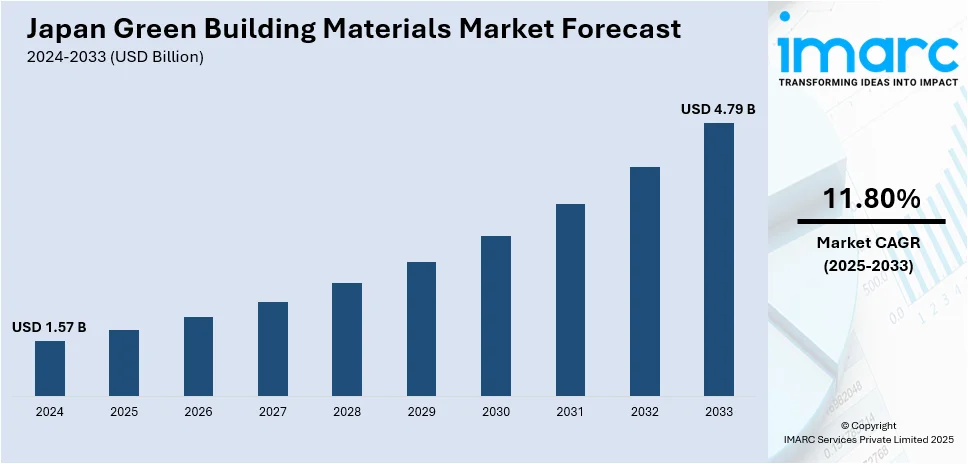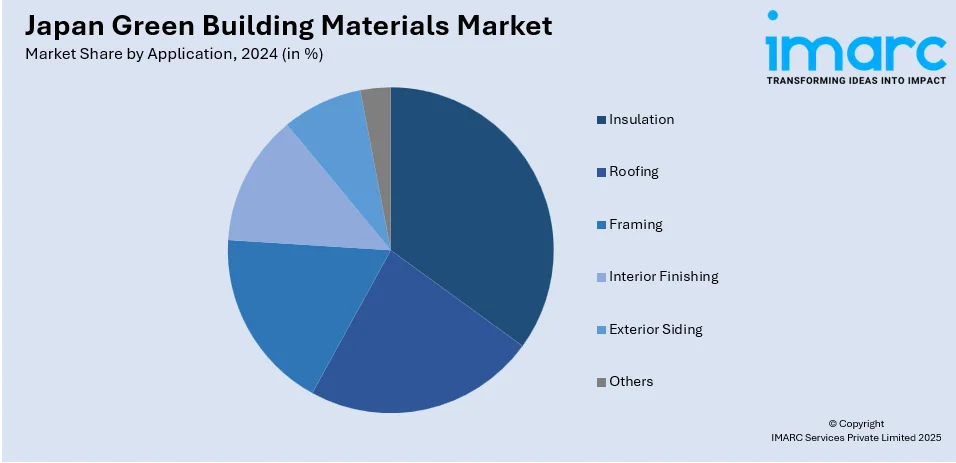
Japan Green Building Materials Market Size, Share, Trends and Forecast by Application, and Region, 2025-2033
Japan Green Building Materials Market Overview:
The Japan green building materials market size reached USD 1.57 Billion in 2024. Looking forward, IMARC Group expects the market to reach USD 4.79 Billion by 2033, exhibiting a growth rate (CAGR) of 11.80% during 2025-2033. At present, the rising development of residential green buildings is driving the demand for eco-friendly, energy-efficient, and sustainable construction products. Besides this, the broadening of retail outlets, which aid in improving accessibility, visibility, and availability of items, is contributing to the expansion of the Japan green building materials market share.
|
Report Attribute
|
Key Statistics
|
|---|---|
|
Base Year
|
2024 |
|
Forecast Years
|
2025-2033
|
|
Historical Years
|
2019-2024
|
| Market Size in 2024 | USD 1.57 Billion |
| Market Forecast in 2033 | USD 4.79 Billion |
| Market Growth Rate 2025-2033 | 11.80% |
Japan Green Building Materials Market Trends:
Increasing development of residential green buildings
Rising development of residential green buildings is positively influencing the market in Japan. As the urban population is growing and environmental concerns are intensifying, homeowners and developers are seeking building solutions that reduce carbon emissions and enhance indoor living quality. Residential green buildings often incorporate materials, such as recycled concrete, low-emission paints, energy-saving insulation, and sustainably sourced wood, which contribute to the growing demand for green materials. Government incentives and building regulations are also supporting this trend, encouraging energy conservation and sustainable design in housing projects. Japan's focus on disaster-resilient construction is further boosting interest in high-performance materials that are both environmentally and structurally sound. Homebuyers prefer materials that improve air quality, reduce utility bills, and increase property value, motivating developers to meet these preferences. Compact housing trends and smart home integration also favor materials that offer durability, thermal efficiency, and low environmental impact. Rising investments in green buildings are stimulating the market growth in the country. According to industry reports, the Japan green building market will grow at a CAGR of more than 3% from 2023-2028.

Broadening of retail channels
The broadening of retail outlets is impelling the Japan green building materials market growth. According to the data released by the government authorities, Japanese retail sales increased by 2.8% in November 2024, compared to November 2023. As more retail outlets and distribution channels continue to focus on green materials, users and builders are finding it easier to explore, compare, and purchase eco-friendly options. Home improvement stores, specialty outlets, and online platforms increasingly stock green products, such as recycled wood and energy-efficient insulation. This widespread availability is encouraging adoption by both professional contractors and individual homeowners. Retailers are also investing in product education, helping people understand the benefits of sustainable choices for health, energy savings, and environmental impact. Retail marketing and promotions spotlight green alternatives, building user trust and influencing purchase decisions. The growing retail network is supporting small and medium-sized green material producers by giving them a broader market presence. As users and developers are becoming more familiar with eco-conscious solutions, the demand is rising steadily. This retail expansion, combined with Japan’s focus on sustainability, is significantly propelling the growth of the market across the country.
Japan Green Building Materials Market Segmentation:
IMARC Group provides an analysis of the key trends in each segment of the market, along with forecasts at the country and regional levels for 2025-2033. Our report has categorized the market based on application.
Application Insights:

- Insulation
- Roofing
- Framing
- Interior Finishing
- Exterior Siding
- Others
The report has provided a detailed breakup and analysis of the market based on the application. This includes insulation, roofing, framing, interior finishing, exterior siding, and others.
Regional Insights:
- Kanto Region
- Kansai/Kinki Region
- Central/ Chubu Region
- Kyushu-Okinawa Region
- Tohoku Region
- Chugoku Region
- Hokkaido Region
- Shikoku Region
The report has also provided a comprehensive analysis of all the major regional markets, which include Kanto Region, Kansai/Kinki Region, Central/Chubu Region, Kyushu-Okinawa Region, Tohoku Region, Chugoku Region, Hokkaido Region, and Shikoku Region
Competitive Landscape:
The market research report has also provided a comprehensive analysis of the competitive landscape. Competitive analysis such as market structure, key player positioning, top winning strategies, competitive dashboard, and company evaluation quadrant has been covered in the report. Also, detailed profiles of all major companies have been provided.
Japan Green Building Materials Market News:
- In September 2024, JAPAN BUILD Tokyo, a thorough trade exhibition for the building and housing sectors, was set to take place in the country. It was scheduled on 11-13 December 2024 at Tokyo Big Sight. The Green Building Expo continued to be a key component of JAPAN BUILD Tokyo, reflecting the industry’s growing emphasis on sustainable methods and eco-friendly alternatives. This specialized area would highlight top firms presenting cutting-edge materials, technologies, and services that aimed to enhance energy efficiency, conserve resources, and lessen environmental impact.
Japan Green Building Materials Market Report Coverage:
| Report Features | Details |
|---|---|
| Base Year of the Analysis | 2024 |
| Historical Period | 2019-2024 |
| Forecast Period | 2025-2033 |
| Units | Billion USD |
| Scope of the Report |
Exploration of Historical Trends and Market Outlook, Industry Catalysts and Challenges, Segment-Wise Historical and Future Market Assessment:
|
| Applications Covered | Insulation, Roofing, Framing, Interior Finishing, Exterior Siding, Others |
| Regions Covered | Kanto Region, Kansai/Kinki Region, Central/Chubu Region, Kyushu-Okinawa Region, Tohoku Region, Chugoku Region, Hokkaido Region, Shikoku Region |
| Customization Scope | 10% Free Customization |
| Post-Sale Analyst Support | 10-12 Weeks |
| Delivery Format | PDF and Excel through Email (We can also provide the editable version of the report in PPT/Word format on special request) |
Key Questions Answered in This Report:
- How has the Japan green building materials market performed so far and how will it perform in the coming years?
- What is the breakup of the Japan green building materials market on the basis of application?
- What is the breakup of the Japan green building materials market on the basis of region?
- What are the various stages in the value chain of the Japan green building materials market?
- What are the key driving factors and challenges in the Japan green building materials market?
- What is the structure of the Japan green building materials market and who are the key players?
- What is the degree of competition in the Japan green building materials market?
Key Benefits for Stakeholders:
- IMARC’s industry report offers a comprehensive quantitative analysis of various market segments, historical and current market trends, market forecasts, and dynamics of the Japan green building materials market from 2019-2033.
- The research report provides the latest information on the market drivers, challenges, and opportunities in the Japan green building materials market.
- Porter's five forces analysis assist stakeholders in assessing the impact of new entrants, competitive rivalry, supplier power, buyer power, and the threat of substitution. It helps stakeholders to analyze the level of competition within the Japan green building materials industry and its attractiveness.
- Competitive landscape allows stakeholders to understand their competitive environment and provides an insight into the current positions of key players in the market.
Need more help?
- Speak to our experienced analysts for insights on the current market scenarios.
- Include additional segments and countries to customize the report as per your requirement.
- Gain an unparalleled competitive advantage in your domain by understanding how to utilize the report and positively impacting your operations and revenue.
- For further assistance, please connect with our analysts.
 Request Customization
Request Customization
 Speak to an Analyst
Speak to an Analyst
 Request Brochure
Request Brochure
 Inquire Before Buying
Inquire Before Buying




.webp)




.webp)












